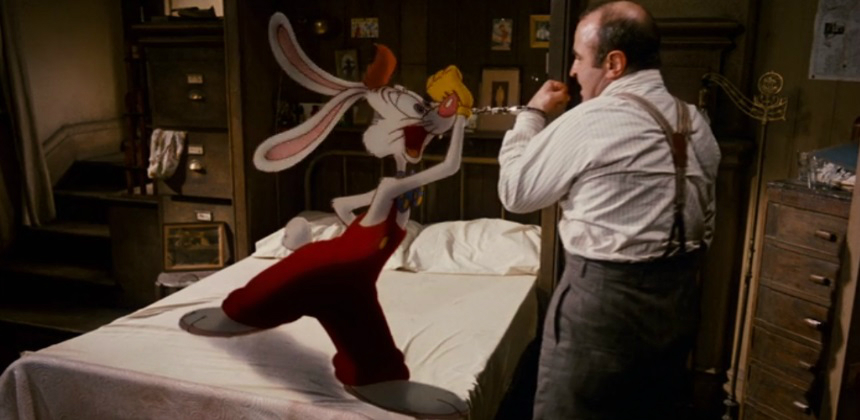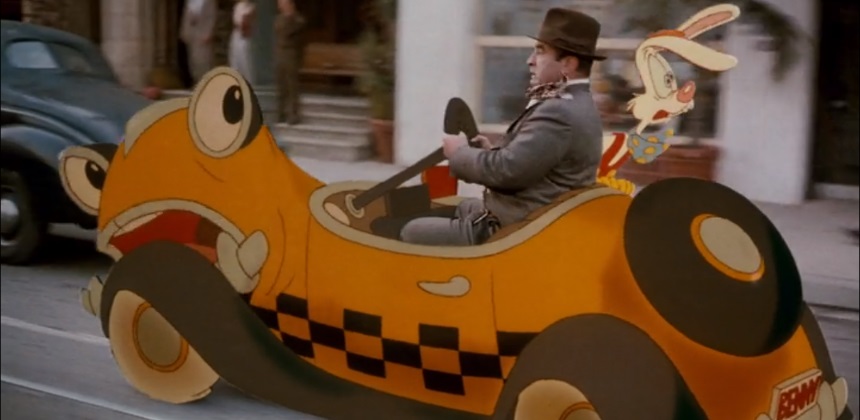10+ Years Later: WHO FRAMED ROGER RABBIT, Much More Than a Spine-tingling Visual Knock-out

Who framed Roger Rabbit? ‘Who indeed?’, is the question I found myself asking a few weeks back when suddenly Robert Zemeckis’ vibrant crossbreed of live action and animation reemerged into my life as a Netflix recommendation. What exactly did they accuse the rabbit of? And why was it necessary to frame him?
Jokes aside, I clearly hadn’t seen the film in ages and could only remember it in the broadest of strokes: a grumpy detective, a hyperkinetic rabbit, Toontown filled to the brim with cameos, and – for some reason – weasels. Except, that’s not entirely true. Circling the play button with my mind already half made-up about revisiting the beloved classic, the multitude of emotions it had triggered into my childhood self resurfaced: wonder, joy, sadness, shock, and frenzied terror (in rapid succession).
Like with most kids who may or may not have been a bit too young when they were first exposed to the film, two vivid images are forever seared into my brain: one of a crazy man with eyes darting out of his skull (Yikes!) and another of an animated shoe agonizingly erased from existence by way of an acid bath (Nooooo!). First things first, though: wonder and joy.
Ingeniously and quite meta, Who Framed Roger Rabbit opens on a movie set. What we believe to be just another cartoon (albeit one in all its gut-busting glory, full of death-defying stunts and over-the-top hijinks) is revealed to be a failed long take of sorts as the director yells ‘cut’ and walks into frame. Sure, it’s an efficient way of introducing our troubled toon protagonist, the beloved Roger Rabbit, who is unable to perform at peak capacity. More importantly, however, without a single line of explanatory dialogue, we enter a world of seemingly infinite possibilities, one in which ‘real’ human beings co-exist with animated characters.
Brilliant immersion aside, the scene ends with audiences also catching a glimpse of Eddie Valiant on set, the film’s human lead. Decked out in detective gear and sporting a stern demeanor, his love of liquor is as apparent as his contempt for toons. Also quite clear: he will become the perfect foil for the zany antics of the toon world, the yin to the film’s yang. As far as ‘show, don’t tell’-openings go, this one holds up. Of course studio boss Mr. Maroon hires him to investigate the Roger Rabbit case, which leads Valiant to a nightclub encounter with both Mr. Acme, owner of Toontown, and the eye-catching Jessica, Roger’s decidedly non-rabbit spouse.

From that moment on, the film unspools as a carefully plotted, noirish crime story without losing sight of whimsical opportunities, be they self-referential (much like the film’s title) or plain old bouts of animated tomfoolery (like Daffy and Donald Duck’s one-of-a-kind piano ‘duet’). In retrospect, despite telling an inventive tale centered around Mr. Acme’s will and the rightful ownership of Toontown, Who Framed Roger Rabbit runs the risk of being needlessly confusing, given the sheer number of people being set-up, framed, blackmailed or otherwise wronged. The zigzagging nature is likely lost on younger viewers and, whether young or old, the mystery sort of dissipates once the eminently sinister Judge Doom enters the fold to murder an innocent shoe (judge, jury and executioner indeed).
Where the film truly shines is in its fusion of genres. Of course the mix of animation and live action is expertly conceived. Interactions between representatives of both worlds are diverse and so persuasive as to make the universe of Who Framed Roger Rabbit palpable. Throwing shadows in the mix was a masterstroke that allowed toons to break free from hand-drawn still frames, bursting with life, dimensionality and agency. The scene in which Eddie first discovers Roger Rabbit sleeping in his office, then hides him in the sink as the weasels (Doom’s henchmen) burst through the door in search of their murder suspect still blows my mind.
This mixture of genres and attention to detail carries over to the sets as well. The look and feel of Eddie’s office and a gritty, rain-soaked alleyway give Who Framed Roger Rabbit the authenticity of a hardboiled novel while the vivacious hustle-and-bustle of Toontown captures the golden age of animation in all its zaniness. Even the leads are operating in different yet complementary modes. Where a surly Bill Hoskins provides fish-out-of-water laughs, Christopher Lloyd’s unblinking Judge is nightmare-inducing in his grim seriousness (before the wheels come off and he becomes even more terrifying).
Not Gremlins but Who Framed Roger Rabbit offered me my earliest experience with horror and the action-packed climax ups the ante. In a final, major set piece, featuring the Judge’s Dipp-spewing machine and plenty of fisticuffs, stakes are high as the fates of Roger and Jessica hang in the balance and the entirety of Toontown risks being replaced by a freeway. Doom is revealed to be a cold-hearted capitalist but also, more importantly, a toon-in-disguise.

After being bulldozed over (!), he disturbingly re-inflates himself (!!), causing his marble eyes to pop out before he turns his demented gaze (!!!) on Eddie. The tea-kettle voice he assumes as eyes lunge out of his skull like daggers and he proudly confesses to having murdered Eddie’s beloved brother? Well, let’s say it ranks high on the list of things with the potential to scar. Despite feeling mortified as a kid, this was hands down my favorite scene in the movie (one I would painstakingly recreate with Lego pieces).
Looking back, it seems safe to say this cavalcade of shocks awakened my love for the instant thrills only horror can provide. As an adult, I still love the sense of escalation and pacing of the climax as well as the ingenious face-off between Eddie and the Judge, whose hand diabolically transforms into what can only be termed an extendable buzz saw. Because his villainy is so enormous there’s a real sense of victory and joy after the Judge’s Wicked Witch-style defeat.
And yet, for all its successful mergers of disparate elements, my rediscovery of the film didn’t come without an eyebrow-raising moment or two. Not even touching the hot potato that is Jessica Rabbit (“I’m not bad, I’m just drawn that way”), Baby Herman’s antics simply struck me as crude. To be sure, an embodiment of juxtaposition can set off comedic sparks, but Baby Herman is a farcy from, for instance, Rick and Morty’s Abradolf Lincler (an amalgamation of Abraham Lincoln and Adolf Hitler who promises to “emancipate” you “from your own inferior genes”). Blatant sexism is never funny, not even if it’s perpetrated by a grown man trapped inside a baby’s body.
And despite loving how jokes that once flew over my head were now able to register (the bouncer of a nightclub is literally a gorilla yet also wears a monkey suit in the figurative sense) I was taken aback by the film’s racial subtext (the Ink and Paint Club where the aforementioned bouncer works is a humans-only establishment in which animated characters are only welcome as entertainers or waiters). All of a sudden (other than sharing DNA as crime comedies) a parallel with Zootopia dawned on me.
Much like Zootopia is a mirror of our troubled times, reflecting through its anthropomorphized carnivores and herbivores a fear of Others while pointing to the dangers of taking preconceived notions for granted, Who Framed Roger Rabbit can be read as an allegorical take on race relations; a disturbing portrayal of its temporal setting in which ‘toons’ are an underclass and, for the most part, segregated to a community all their own. Again, ‘show, don’t tell’, but of a more problematic variety since Who Framed Roger Rabbit fails to comment (unlike Zootopia, which actively challenges and dismantles stereotypes). This is where the film’s nostalgic invocation of the past (golden age Hollywood) is either dangerous or too simplistic.
Being suddenly aware of its 1940s setting and what that means doesn’t take away from the film’s many accomplishments but it deepens what I once mistook for children’s entertainment. To put it differently: R. K. Maroon’s praise for Dumbo as a valued employee willing to work for peanuts is still funny on a surface level but it possibly extends beyond that, which gives me pause.






